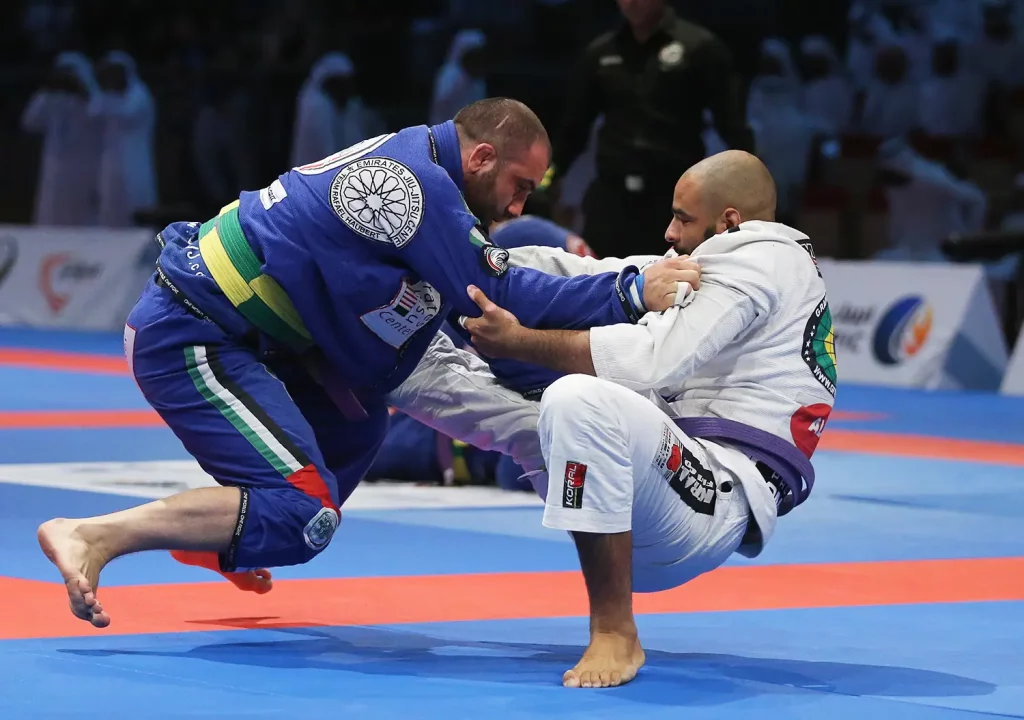26 de May de 2025
BJJ Strength and Conditioning Program
Brazilian Jiu-Jitsu (BJJ) demands technical precision, tactical awareness, and a unique combination of endurance, strength, and flexibility. Unlike striking-based martial arts, BJJ competitions often unfold predominantly on the ground, requiring athletes to push, pull, and brace against resisting opponents. A well-designed BJJ strength and conditioning (S&C) program helps practitioners develop the physical robustness to complement their technical skills, leading to more dominant positions, effective escapes, and sustained rolling performance.
Below, I’ve compiled a structured guide for coaches and athletes looking to optimize their BJJ training. You’ll find actionable insights on the specific physical qualities BJJ requires, how to periodize workouts around tournaments, and ways to integrate innovative technologies such as Velocity Based Training (VBT).

Why Is Strength and Conditioning Critical for BJJ?
1. Muscular Strength and Control
In BJJ, controlling an opponent means dictating position and limiting their movement. A stronger athlete can leverage even minor positional advantages, whether pinning an opponent in side control or stabilizing while passing guard. Foundational movements like squats, deadlifts, and pressing variations build full-body strength crucial for preventing sweeps and maintaining offensive pressure.
2. Grip Endurance and Isometric Strength
Few martial arts rely on grip strength as much as BJJ. Athletes often hold collars, sleeves, and pant legs while rolling. Training the forearms and hands for repeated or prolonged grips is essential. Isometric exercises (e.g., farmer’s carries, static hangs) build the capacity to clamp down on a lapel or secure a kimura grip without fatigue.
3. Explosive Power for Transitions
Although BJJ is sometimes described as a “human chess match” that emphasizes flow and leverage, short bursts of explosiveness can be a game-changer. Exploding into a scramble, bridging with power to escape side control, or swiftly transitioning from guard to a submission all require rapid force production.
4. Cardiovascular and Muscular Endurance
Rolling sessions can last multiple minutes with limited breaks. Success in these grappling exchanges depends on both aerobic capacity (for prolonged effort) and anaerobic power (for repeated high-intensity bursts). Balancing these qualities ensures you won’t burn out halfway through a match.
5. Flexibility and Mobility
BJJ positions (rubber guard, inverted guard, etc.) demand high ranges of motion. Joint mobility and flexibility protect against common injuries, like joint locks and muscle strains, while enabling you to maximize technical options.
Core Elements of a BJJ Strength and Conditioning Program
- Foundational Strength: Emphasize compound lifts (squats, deadlifts, rows, presses) to build total-body stability and power.
- Specific Muscular Endurance: Incorporate circuits or intervals that mirror the intensity and work-to-rest ratios found in rolling.
- Grip Training: Use thick-bar attachments, gi pull-ups, or farmer’s carries to address isometric demands.
- Explosive Movements: Kettlebell swings, Olympic variations, and plyometrics help convert raw strength into match-ending power.
- Mobility and Recovery: Incorporate dynamic warm-ups, targeted flexibility work, and active recovery sessions.

Structuring Your BJJ S&C Program
Phase 1: Off-Season / General Preparation (6–8 Weeks)
- Focus: Build base strength, correct muscular imbalances, and develop aerobic capacity.
- Sample Workouts:
- Strength Day: Barbell back squats 4×5, weighted pull-ups 4×6, barbell rows 3×10, farmer’s carries 3×30s.
- Conditioning Day: Interval running (6×400m @ moderate intensity, 60s rest) or circuit training (push-ups, plank holds, med ball slams).
- Grip Emphasis: Towel pull-ups, dead hangs, or pinch-grip plate holds.
- Mobility: Hips, shoulders, thoracic spine.
- Strength Day: Barbell back squats 4×5, weighted pull-ups 4×6, barbell rows 3×10, farmer’s carries 3×30s.
Phase 2: Pre-Competition / Specific Preparation (4–6 Weeks)
- Focus: Convert base strength into explosive power and BJJ-specific endurance.
- Sample Workouts:
- Power-Strength Day: Hang cleans 4×3 @ 60–70% 1RM, band-resisted push-ups 3×8, single-leg Romanian deadlifts 3×10.
- Functional Circuits (3–5 rounds):
- Kettlebell swings (15 reps)
- Gi pull-ups (6–8 reps)
- Medicine ball rotational throws (5 per side)
- Shuttle runs (30–40m)
- Kettlebell swings (15 reps)
- Power-Strength Day: Hang cleans 4×3 @ 60–70% 1RM, band-resisted push-ups 3×8, single-leg Romanian deadlifts 3×10.
High-Intensity Grappling Drills: Partner drills simulating guard passing, takedown entries, or positional scrambles for short bursts.
Phase 3: Competition Taper / Maintenance
- Focus: Maintain strength while prioritizing technical rolling and recovery.
- Sample Workouts:
- Maintenance Strength: 3×3–5 for key lifts at ~75% 1RM (squats, rows, overhead presses).
- Low-Volume Power: 2×3 box jumps or explosive push-ups.
- Recovery Emphasis: More active rest, minimal heavy lifting to keep muscles fresh for tournaments.
- Maintenance Strength: 3×3–5 for key lifts at ~75% 1RM (squats, rows, overhead presses).

Integrating Velocity Based Training (VBT)
One way to optimize each phase of your BJJ S&C plan is by leveraging Velocity Based Training. Using a VBT device, coaches can measure how fast you move a given load in real time.
- Daily Readiness Checks: If your usual speed at 70% 1RM is noticeably slow, it may indicate fatigue, so you can adapt the session accordingly.
- Load Velocity Profiling: Map out how bar speed correlates with weights. This data helps set precise intensities for strength or power work.
- Velocity Zones for Explosive Movements: When training jumps, cleans, or kettlebell swings, staying in the correct velocity range ensures you’re actually working on power, not just moving heavy loads slowly.
Managing Fatigue: Monitor “velocity loss” in each set. Once bar speed drops below a threshold, stop or lower the weight to avoid overtraining and keep quality high.
| Day | Session | Details |
|---|---|---|
| Monday | Strength + Power | Hang cleans, heavy squats, grip |
| Tuesday | Technical BJJ (positional sparring) | Guard passing, submissions, escapes |
| Wednesday | Conditioning (HIIT or circuit training) | Kettlebell swings, sprints, rope pulls |
| Thursday | Technical BJJ (drilling & live rolling) | Takedowns, guard retention, advanced transitions |
| Friday | Low-Volume Strength / Maintenance | Overhead press, unilateral work, core |
| Saturday | Open Mat or Extra Cardio | Light, steady-state rolling or 30-min run |
| Sunday | Rest / Active Recovery | Mobility session, yoga, easy stretching |
Key Considerations for BJJ Athletes
- Balance Skill Work and S&C: BJJ technique is priority number one. Ensure S&C volumes do not compromise rolling frequency or technical learning.
- Injury Prevention: BJJ can be tough on knees, shoulders, and necks. Focus on correct lifting form, joint stability exercises, and consistent warm-ups.
- Adapt to Body Composition Goals: Some fighters need to cut weight for tournaments. Adjust training intensity, add or reduce cardio, and coordinate with nutrition to maintain strength.
- Plan for Tournament Cycles: Peak for major competitions by reducing volume about 1–2 weeks out, focusing on speed, mobility, and efficient sparring sessions.
- Track Progress: Keep logs or use a VBT sensor to track speed, loads, and any dips in performance that might signal overtraining.
Final Thoughts
A carefully designed BJJ strength and conditioning program elevates both your offensive threats (stronger submissions, explosive transitions) and your defensive resilience (staying safe under pressure, maintaining tight grips). By structuring phases for strength building, power development, and tournament tapering—and harnessing real-time feedback from velocity-based training devices—you can approach every roll and match with increased confidence.
Whether you’re a casual hobbyist aiming for improved mat performance or a serious competitor chasing podium finishes, an S&C program that addresses BJJ’s unique demands will pay dividends. Combine thoughtful periodization, consistent grip training, and essential mobility work to ensure you remain adaptive, injury-free, and ready to impose your game on any opponent.
